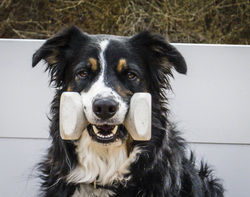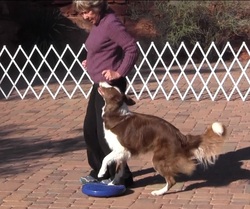
Unfortunately this same lack of connection, joy and interaction is all too common in agility. One would think that agility is so much more fun for dogs and handlers than obedience but just watch the number of people that do not connect with their dogs before entering the ring. And after the run, where is the shared joy? How many dogs just trot around the course and do not seem to show that they are having fun?
A few years ago I had knee surgery and could only work my Border Collie Kaffee, who had been competing in agility, at our home in obedience. I started using his tugs and balls before we worked. His reward as we worked was his tug, favorite balls, or perhaps a very high value treat. Kaffee always smiled when he worked and seemed to enjoy obedience or whatever we were sharing together. When I was able to return to our training field Kaffee would run over to the obedience ring with joy and a smile. This joy and happiness is transferred to his obedience showing.
So what have I learned from my journey with training 3 Border Collies and 2 Puli about motivation, joy, team work and connections?
TIP #1: Play with your dog. Teach your dog to find the joy in tugging or playing with a ball with you. A number of years ago when I was training my Puli who are not interested in toy play when training, I read an interesting book from one of the early agility teachers in Canada. She wrote that when working her Sheltie she often spent the majority of time teaching him how to play since toy play is so important in building drive.
Incorporate the toy play into your training whether it is obedience or agility. My two Border Collie Kaffee and now Myst enjoy their obedience training since it is all about fun, toys and high value rewards for good effort. We warm up exactly the same for our work in obedience and agility. We tug and interact with a ball before, during and after our training. This keeps them happy and looking forward to more.
TIP #2: Teach your dog a few tricks like hand touches, passes through your legs, circles and spins. These tricks when taught with reinforcement become fun and exciting for dogs. These tricks are excellent for warming your dog up before obedience and agility. These same tricks can be used before you go into the ring and also between exercises in obedience to help keep your dog focused, connected with you and motivated. When training use a few hand touchs or spins at your side to improve the joy for heeling.
Before we go into the ring Kaffee does 3 circles at my side, gets a treat and then enters the ring. Myst does nose touches. You can see their happiness and joy when you do these tricks before going into the ring. I am connecting with my dog, starting with a focused dog, and have just had fun with them before beginning our exercises.
Have a procedure of what you do before you go into the ring and keep it the same. Dogs like structure especially if it involves fun and a wonderful treat.
TIP #3: Be fair to your dog. So many dogs are confused about what we expect of them. Smart Animal Training Systems blog had a posting, “Bob Bailey: Don’t settle for good enough”. In this very interesting article Bob Bailey was quoted as saying, “during training sessions, many trainers accidentally also reinforce what is NOT wanted, have poor timing and don’t set clear criteria… But let’s face it; dogs are a very forgiving species. Through our inconsistencies, confusing body signals, poor timing, stingy reinforcement rates, constant talking and moving, changes in tones of voice, etc., our dogs are still capable of figuring out what’s the best way to get the treat.”
http://blog.smartanimaltraining.com/2013/09/23/bob-bailey-dont-settle-for-good-enough/
Obedience is full of examples of inconsistent training. A dog may lag when heeling but is given a treat. When asked to front the dog is not straight but gets rewarded; finishes are crooked so often but still the dog gets rewarded. When asked to drop in the recall, the dog takes several steps before going down…. But is still allowed to continue.
And in agility, do we see inconsistency all the time when asking for contact behaviors and weave pole work? Our dogs pull bars when jumping. Do our dogs know the criteria we are looking for? Do they get rewarded for just doing something? Or do we let them know the criteria we are expecting.
Before you begin training an exercise, read about it, ask your instructor and watch good examples of this exercise being performed. Get a clear picture of what you want your dogs performance to look like. You may need to break the task into small training tasks (shaping) but only reward for what is good effort AND the expected performance for the stage of training. If you are doing obedience read the AKC rules and regulations book on the class exercises you will be doing. What will YOU or your dog be scored points off for doing or not doing? Yes, handlers get points taken off for their mistakes also.
When you first start training a dog, you need to show them what the behavior is. Then when you ask the dog for that behavior you will reinforce good effort and the behavior being performance. However, when the dog knows the behavior, then you only reward for the performance of 50% correct or better. Do not reward for incorrect performance. Be fair and consistent. If you only reward for a correct contact performance, completed weave poles, straight fronts and finishes, focused heeling etc. then the dog knows the criteria for that performance. If you reward for less then the best, you are not asking for enough and the dog will have quickly figured out the easiest way to get the treat.
Tip 4: Do not allow your dog to be incorrect. If a dog starts to do a behavior incorrectly and you allow him to complete the task, it will be very difficult to teach the dog the correct criteria and improve the incorrect performance. For example if the dog enters the weave poles incorrectly, skips a pole or comes out, and you never mark the error with a negative verbal marker like “opps”, then the dog is not learning what is correct. The same is true of pulling bars in jumping. If the dog drops a bar and you allow them to continue then how does the dog know that it is his responsibility to keep the bars up. If the bar is dropped, STOP... PAUSE FOR 10 seconds; put the bar back up and ask the dog to perform the jump again. If the bar stays up, verbally reward the dog. Then ask the the sequence preceding the dropped bar. If performed correctly, then it is PARTY TIME for the toy play or treat.
The same is true in obedience. Do not allow unfocused heeling. When the dog is in the ready position and heeling is to begin, be sure you have their attention. DO NOT, take a step until you have focus. You may need to go back to focus in ready position and one step with focus for a reward… but do not continue with heeling when you have lost your dog and do not have focus.
Tip 5: Think “Training Obedience/Agility” is Just Another Trick” If you approach your training with a different mental attitude such as you should when training tricks or working on balance discs, your positive happy approach is picked up by your dog. If you approach heeling work with, “I really do not like heeling, it is so boring” then your dog will never heel happily and well. But rather think “heeling is just another trick” and make the steps to focused heeling fun and rewarding for both you and your dog.
Don’t just do robotic training: endless heeling, running the same course over and over in agility, repeating the same obedience exercises over and over. Everything you do with your dog should be done with a reason – to help improve their understanding of the behavior and help them to reach the next level.
Happy Heeling...

 RSS Feed
RSS Feed